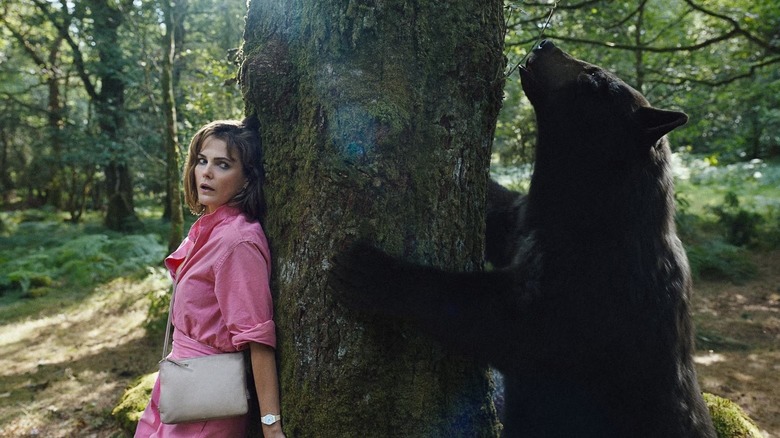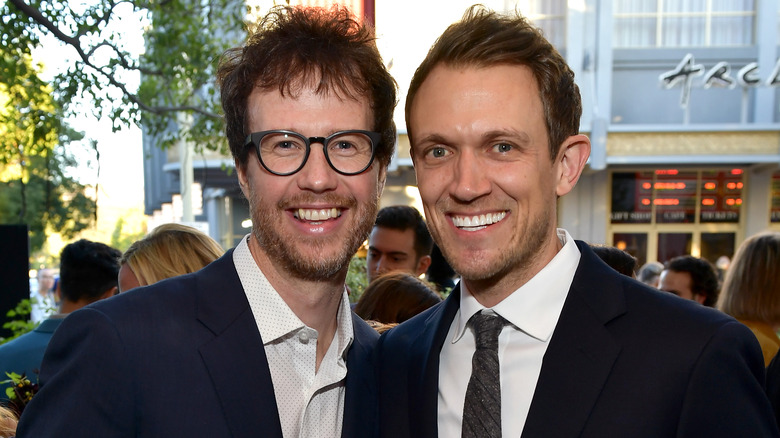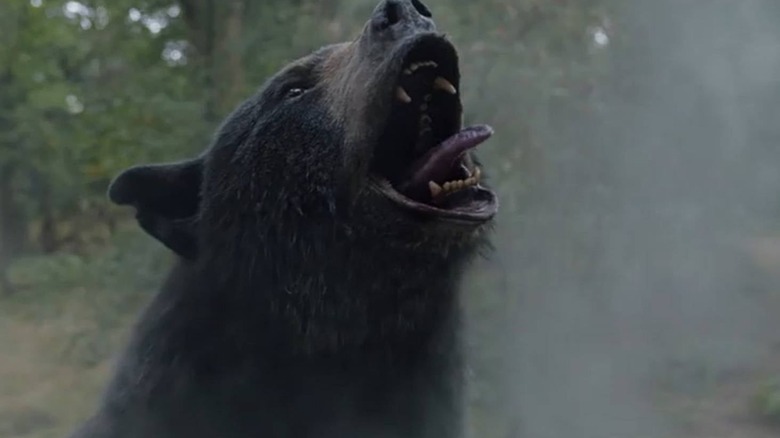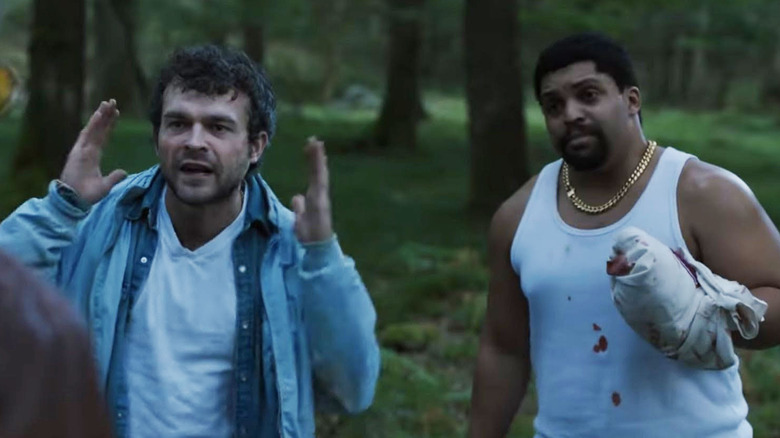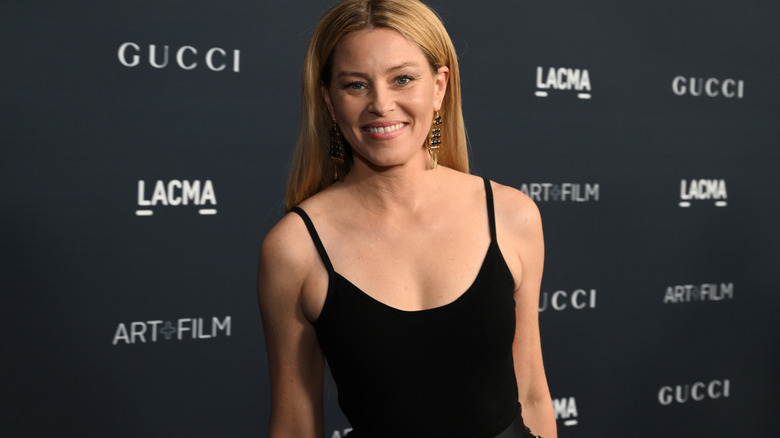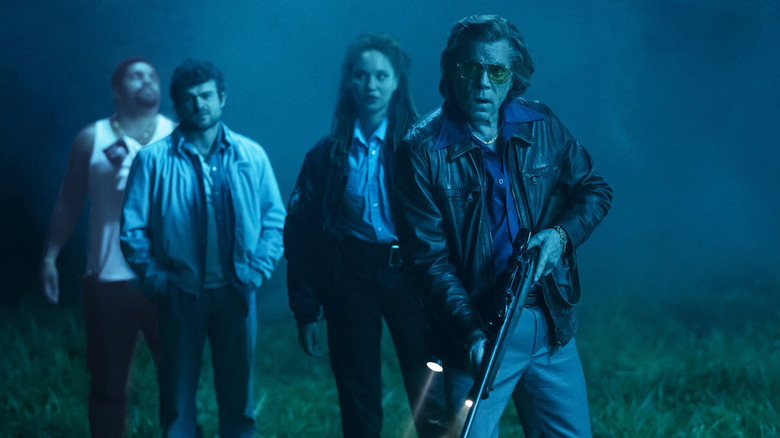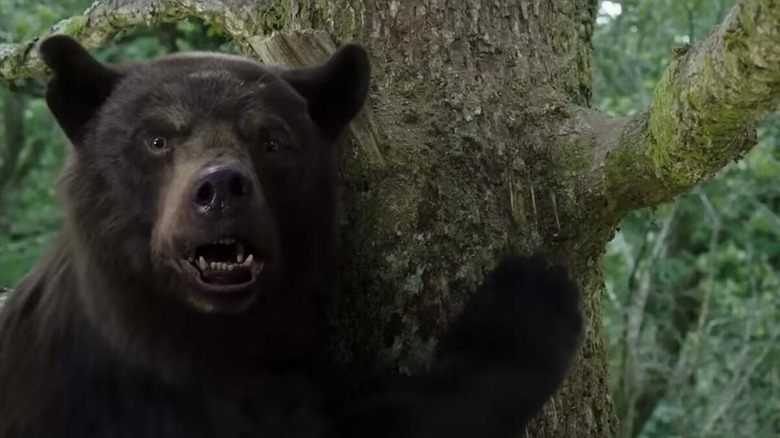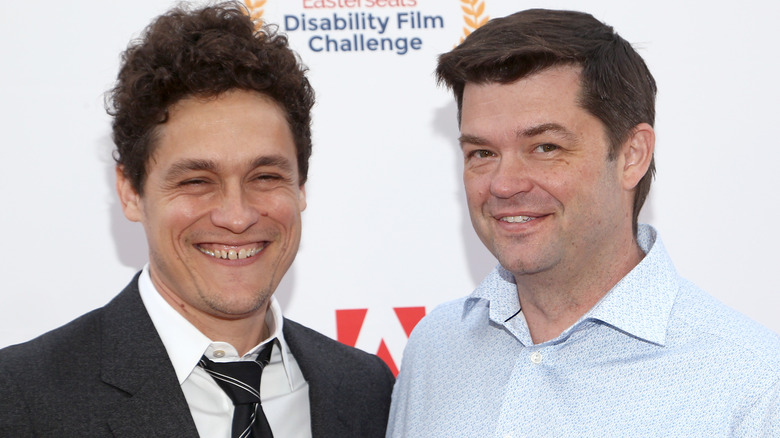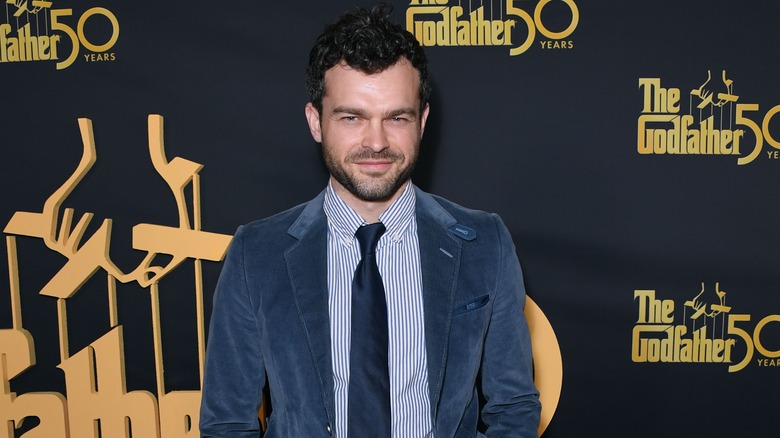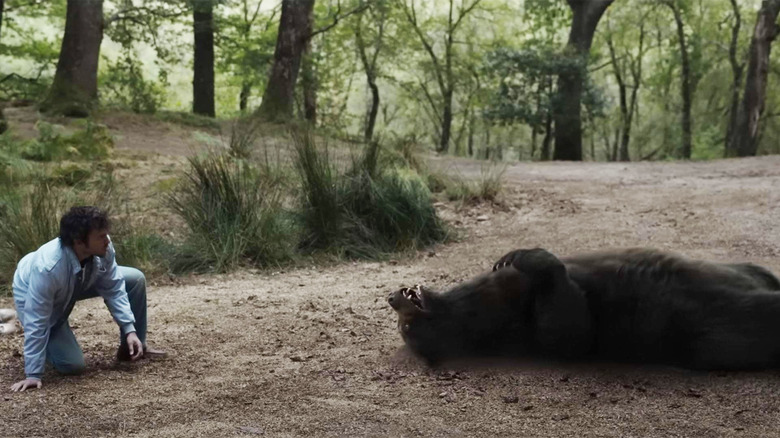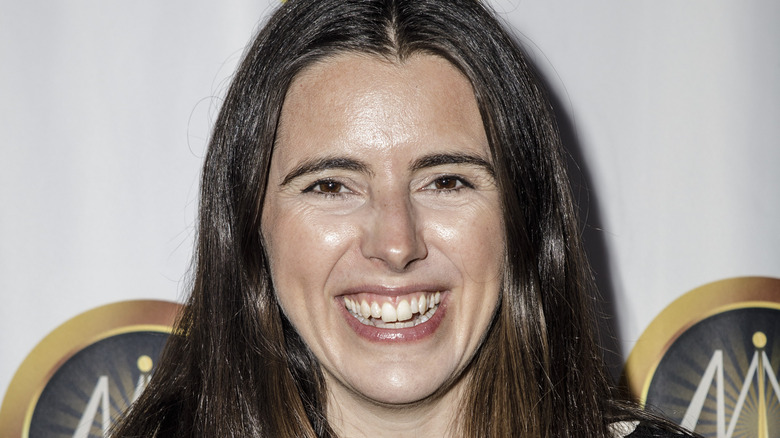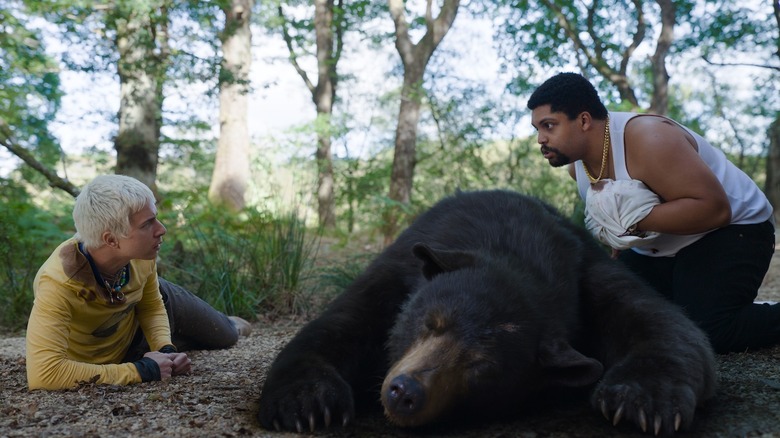Take A Hit On These Grizzly Cocaine Bear Facts
Cocaine was everywhere in the 1980s and it proved so rampant that even a big black bear had to get a sniff of it. That's the starting point for "Cocaine Bear," a new movie from director Elizabeth Banks that uses a true story about a bear that accidentally ingested an unspeakable amount of cocaine as a launchpad for an original gruesome yarn. This expansion on the original tale involves the coked-up bear going on a rampage against a whole bunch of human beings in Georgia. The carnage is gnarly, the cocaine is omnipresent, and the body count is rising about as fast as this bear can run. You get all of that inside "Cocaine Bear," which is bound to take the prize for the 2023 movie featuring the most bear carnage.
Making something this gruesome doesn't happen overnight, though. The process of bringing "Cocaine Bear" to life was a lengthy one and this assortment of facts about the movie reflect what a unique creative process it was to realize this particular motion picture. Among these facts are revelations on who was originally set to director "Cocaine Bear," the creative inspirations for the movie, where the feature was shot, and so much more. All these elements show the kind of thought that was put into making "Cocaine Bear," a movie that takes the narrative form of "man vs. nature" to much more extreme heights.
The original directors of Cocaine Bear
While certain key creative personnel, like producers Phil Lord and Chris Miller, were involved with "Cocaine Bear" from the start, the project started life with a wildly different director at the helm. For one thing, it once had two directors steering this ship in the form of Matt Bettinelli-Olpin and Tyler Gillett. When the pair were hired for the film in December 2019, it had only been a few months since the duo's August 2019 hit "Ready or Not." With that film deftly combining horror and comedy within an outlandish premise, it's no surprise the pair were on the radar of the "Cocaine Bear" team.
This duo has been quiet in terms of what their vision would've been for "Cocaine Bear" and there's never been an official reason for why they left the film. However, it's very likely a competing project eventually secured Bettinelli-Olpin and Gillet's time and attention. Just three months after being first attached to "Cocaine Bear," the duo was reported to be directing a new "Scream" movie, which was aiming to start filming as soon as the summer of 2020. While the start date for that project got postponed, this pair of filmmakers would eventually helm that "Scream" installment, with the opportunity to tackle Ghostface taking up their energy instead of "Cocaine Bear."
How Jimmy Warden came to write the Cocaine Bear script
One of Patton Oswalt's most memorable bits of stand-up comedy comes when he's complaining about how hard it is to write screenplays for movies, especially when the movie "Death Bed" exists. As Oswalt notes, this ludicrous-sounding horror film still required some human being to get up and burn the midnight oil churning out page after page about the vicious bed. Worst of all, Oswalt notes, is the inevitable fact that this screenwriter must have had writer's block at some point and kept on pushing through to write "Death Bed." Every movie, no matter how ridiculous, has a screenwriter behind it toiling away to make the best feature possible. Just ask Jimmy Warden, the writer of "Cocaine Bear."
Warden explained to Variety that, naturally, a story as random yet based on a real historical event as "Cocaine Bear" would have to start on Twitter. Warden stumbled onto a post about the real-life Cocaine Bear on this social media platform and that sent him down a rabbit hole about this creature. Immediately, this screenwriter was hooked on the plot and wanted to make a movie emphasizing the bear's perspective, especially since he'd both seen bears and dabbled in cocaine in his life. With that, Warden took a cue from the screenwriter of "Death Bed" and proceeded to churn out a screenplay over newly-imagined vicious exploits involving a bear who ingests a lot of cocaine.
The real-life Cocaine Bear story is a bit different from the movie
The "Cocaine Bear" marketing has emphasized a story about a bear who ingests cocaine and proceeds to go on a violent rampage that takes out countless scummy humans along the way. While this feature is technically based on a true story, the real inspiration for "Cocaine Bear" is much more muted than what's been on this movie's posters and trailers. The true story of this bear involves drug smuggler Andrew Thornton II (portrayed in "Cocaine Bear" by Matthew Rhys), who did indeed airdrop some cocaine that a massive black bear ingested. However, when this bear took in the gargantuan amount of cocaine that had been dropped from the plane, it wasn't long before the beast was dead.
The bear's body was then taxidermized and set up for display first in the Chattahoochee River National Recreation Area before becoming a possession owned by Waylon Jennings. After traveling through multiple owners, the bear was eventually brought to its current home in a mall in Lexington, Kentucky, where its past was laid out via plaque for visitors. That's a tall tale in and of itself, but the "Cocaine Bear" movie embellishes an already impossible story by giving this bear a bloody coked-up rampage. Director Elizabeth Banks has been quite open about the film's departure from reality and even told Variety that she saw the movie as a way of giving the bear some revenge against the people that caused its demise.
What got Elizabeth Banks excited to direct Cocaine Bear
There were a couple of key factors that lured Elizabeth Banks to the director's chair on "Cocaine Bear." For one thing, she told Variety that she was very conscious of the kind of movies women directors get offered in Hollywood. Action movies full of visual effects and gore aren't typically the kind of movies ladies get invited to helm very often. Having already directed two other motion pictures, Banks was eager to make something so strange and unexpected that it broke down some of those incoherent conceptions of what women directors were capable of.
It didn't hurt that Banks was enamored with the movie the moment she got the script. While reading it, Banks immediately could visualize the look of "Cocaine Bear," particularly just how gory and graphic it could be. Having been such a massive fan of stuff like "Evil Dead" growing up, the idea of directing a fun movie packed with blood like "Cocaine Bear" was an opportunity Banks couldn't pass up. Plus, Banks was excited to be working with people she had positive prior experiences with, such as Universal head Donna Langley (who oversaw "Pitch Perfect 2," the directorial debut of Banks) and producers Phil Lord and Chris Miller (who directed Banks in "The LEGO Movie"). Put all that together and it's no wonder Banks was ready to get grizzly on "Cocaine Bear."
The creative inspirations for Cocaine Bear
When you hear the title "Cocaine Bear," it sounds unlike any other movie in history. Where else have audiences been able to fully grapple with the possibilities of a bear ingesting a lot of cocaine and going on a violent rampage? However, even with such an unprecedented premise for a motion picture, director Elizabeth Banks still had some very specific creative touchstones to guide her vision for this motion picture.
Talking to Empire Magazine (via SYFY), Banks turned to movies directed by Quentin Tarantino, Sam Raimi, and Joel and Ethan Coen when it came to molding the tone of "Cocaine Bear." All of these filmmakers make sense as people who would help inspire the madness of "Cocaine Bear," with each of them showing a gift for complex tones while Raimi and Tarantino are famous for merging laughs with grisly violence. Meanwhile, Joel and Ethan Coen have made some of their most beloved movies out of premises that are perfect for farces. What, then, is the core premise of "Cocaine Bear" if not as perfect of a set-up for a farce as the Coen's "Burn After Reading?"
Granted, none of these veterans and highly influential directors could offer much guidance on how to depict a bear in the middle of a coke-filled rage. But the directors Banks was inspired by did offer a template for how to handle an intricate tone and ludicrous premises.
Keri Russell saw Cocaine Bear as a chance to escape
If you're an actor and you get handed the screenplay for a movie called "Cocaine Bear," a lot of different thoughts are bound to race through your mind. Chiefly, "How're they gonna pull that off?" Among those other questions would have to be, "Do I want to be a part of this?" The whole thing sounds so ludicrous that it could go so horribly wrong that it damages your career forever. However, there's also the possibility that it could end up being so exhilarating that it ascends you to a new level of stardom. A wildly unpredictable concept like "Cocaine Bear" could have an equally unknowable impact on an actor's career, though Keri Russell threw caution to the wind and happily embraced all the uncertain madness of the feature.
Russell explained on The Today Show that what really attracted her to doing "Cocaine Bear" was simply that it seemed like a great way to get some escape from the world. The last few years have delivered no shortage of hardships for the human race, primarily through the COVID-19 pandemic. With "Cocaine Bear," Russell saw an opportunity to put out some excitement and fun into a world that seemed so riddled with despair. That thought, above all others, dominated the mind of Keri Russell once she was first offered a chance to party with "Cocaine Bear."
Cocaine Bear was shot in Ireland
So many of our modern movies and TV shows are now shot in Atlanta, Georgia. Lucrative tax incentives have made the place a go-to location for shooting a variety of projects, with long-running productions like "The Walking Dead" and various Marvel Cinematic Universe projects calling Atlanta, Georgia home. The ubiquity of Georgia as a backdrop for shooting major movies makes it ironic that "Cocaine Bear," a movie set in Georgia, wasn't actually shot in this state. Instead, "Cocaine Bear" used Wicklow, Ireland as a stand-in for Georgia.
Shooting overseas rather than in the United States has been a long-running technique for saving some bucks on your production, so it's no surprise that a movie like "Cocaine Bear" would go this route. Plus, Ireland has a thriving film industry that makes it especially useful to shoot movies in while its abundance of forests made it perfect for "Cocaine Bear," a movie about a bear in a forest who ends up going on a rampage. There are lots of factors in play that make it pretty mundane that "Cocaine Bear" would opt to shoot in international territories. However, given the ubiquity of Atlanta, Georgia as a center for filming projects in the modern pop culture landscape, it's still amusing that one film that didn't exploit that ubiquity was a feature set in Georgia like "Cocaine Bear."
Cocaine Bear's significance for producers Phil Lord and Chris Miller
In August 2019, Phil Lord and Chris Miller and their production company signed a first-look deal with Universal Pictures that ensured this legendary movie studio would be getting its hands on many future movies the duo produced and directed. This news was a harbinger of many events, including just how prolific this duo had become. About 10 years after directing their first movie, "Cloudy with a Chance of Meatballs," Lord and Miller were now planning to ramp up their production company's output to include films from other filmmakers that they would now produce. The once-novices in Hollywood filmmaking were now planning to shepherd a new generation of directors with the assistance of Universal Pictures.
At the time, it was unclear what the first title out of the gate from this partnership would be, with the COVID-19 pandemic's impact on the film industry ensuring that it would be a while before the world saw the results of this union. Years later, "Cocaine Bear" emerged as the first title from Universal's partnership with Lord and Miller. In a way, "Cocaine Bear" is a mighty fitting motion picture to serve as the kickoff for this deal given how its ludicrous premise and complicated tone evoke qualities many people associate with Lord and Miller productions. Plus, the project being directed by Elizabeth Banks reaffirms that this deal won't solely result in Lord and Miller's directorial efforts.
Combining pathos and weirdness got Alden Ehrenreich hooked on Cocaine Bear
In his career as an actor, Alden Ehrenreich has worked with a shockingly eclectic and iconic collection of directors, ranging from Park Chan-wook to Joel and Ethan Coen to Francis Ford Coppola. His affinity for working with auteurs speaks to how he isn't afraid to tackle unusual material. Ehrenreich isn't here to take on roles that an algorithm told him are going to be lucrative; he's here to try fresh ideas and push some boundaries. This trademark in his filmography continues with his work in "Cocaine Bear," which Ehrenreich was attracted to appearing in because of the movie's complicated tone.
Ehrenreich explained to The Movie Times that a movie about a bear who does cocaine was enough of a hook to immediately get him interested in appearing in "Cocaine Bear." But what really got him hooked on the feature was how the script embraced the unabashedly weird nature of its central premise combined with some genuine pathos. This wasn't just a bunch of hollow shock value, "Cocaine Bear" was interested in getting viewers invested in its ragtag group of characters. Reading such a vivid combination in the screenplay, Ehrenreich knew he just had to be a part of this movie.
The titular bear of Cocaine Bear was supposed to look realistic ... sort of
Since it's a live-action movie based on a true (if insane) story, director Elizabeth Banks knew that the titular creature of "Cocaine Bear" had to be convincing to viewers on some level. Banks explained to Empire Magazine (via SYFY) that, from day one of working on "Cocaine Bear," she recognized the importance of convincing the audience that there was a reality to the film's bear. If that tangibility vanished, it was going to be impossible to keep audiences invested in all the mayhem. Thus, Banks gave a mandate to the visual effects team to design this beast in a manner that would ensure it could function as a protagonist, but still constantly evoked a real animal.
Of course, even with that mandate in place, Banks and the VFX team did fudge the reality of the bear a bit to justify certain action beats or story details. Banks excused such deviations from reality as simply being a result of the bear being on so much cocaine. Though the movie concerns a story that feels too preposterous to be true, the "Cocaine Bear" creative team always kept in mind the importance of some level of reality with the visual effects of its furry lead characters.
The original composer of Cocaine Bear
At the start of 2022, it was reported that Natalie Holt would serve as the composer of "Cocaine Bear." Holt exploded in her notoriety when she scored the first season of "Loki" before also composing the score for "Obi-Wan Kenobi" in 2022. This pair of productions put her on countless people's radar and doing a big transgressive comedy like "Cocaine Bear" could've been a fine next step for this artist. However, she would not end up composing the score for "Cocaine Bear," with no official reason given for her departure. Her absence here could simply be down to scheduling issues related to her commitments to other projects like the second season of "Loki."
Instead, Mark Mothersbaugh is the official composer of "Cocaine Bear," with his presence on the project making a lot of sense in terms of his prior connections to key creative personnel on the film. In 2015, he composed the score for the feature-length directorial debut of Elizabeth Banks, "Pitch Perfect 2," while Mothersbaugh goes back even further with producers Phil Lord and Chris Miller. After doing the score for their feature-length directorial debut "Cloudy with a Chance of Meatballs," Mothersbaugh reunited with Lord and Miller on several other projects that the duo has either directed or produced. Given his close ties to these people, it's no surprise Mothersbaugh wound up doing the score for "Cocaine Bear."
The Cocaine Bear trailer that went viral
On November 30, 2022, Universal Pictures uploaded to its YouTube channel the first-ever trailer for "Cocaine Bear." This NSFW sneak peek at the film was a reminder of what happens when marketing for non-franchise fare really takes off. For big expensive blockbuster sequels, marketing materials can also become exceedingly popular, but thanks to months or even years of pre-release speculation, they're often dominated by imagery and dialogue that people were expecting to see. An out-of-the-blue non-sequel like "Cocaine Bear," though, generated a much greater and more unique level of excitement once its first trailer hit. Most people had no idea this movie was on the horizon ... but now they'd never forget about it.
The trailer, propelled by the energetic beats of the Melle Mel tune "White Lines (Don't Don't Do It)," quickly went viral on the internet. The totally unique story at the heart of this forthcoming movie, not to mention the lack of similar animals-gone-wild movies in the modern theatrical cinema marketplace, made it immediately stand out to people all across the internet. Yasmin Tayag of The Atlantic did a thoughtful piece breaking down the various reasons the trailer resonated so powerfully with people, including a primal urge from moviegoers to watch a bear dish out violent vengeance against crude humans. Whatever the reason for its popularity, the "Cocaine Bear" trailer alone was a massive hit and got audiences hankering for even just a sniff of the final film.
